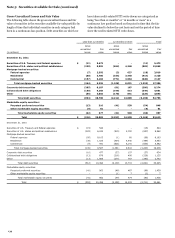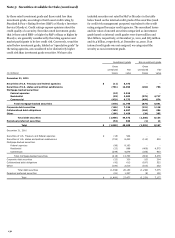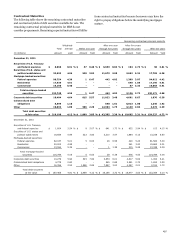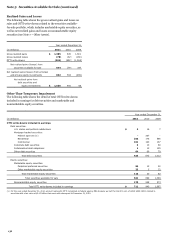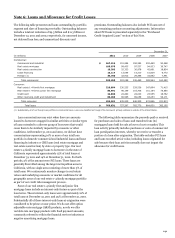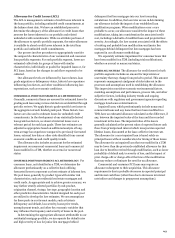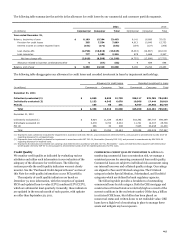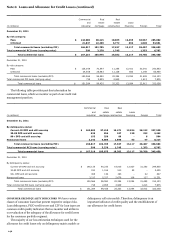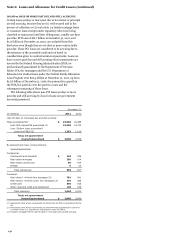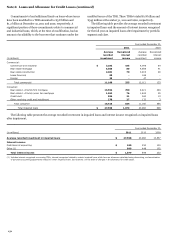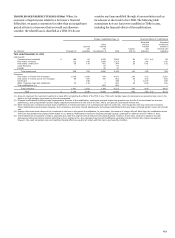Wells Fargo 2011 Annual Report Download - page 145
Download and view the complete annual report
Please find page 145 of the 2011 Wells Fargo annual report below. You can navigate through the pages in the report by either clicking on the pages listed below, or by using the keyword search tool below to find specific information within the annual report.Allowance for Credit Losses (ACL)
The ACL is management’s estimate of credit losses inherent in
the loan portfolio, including unfunded credit commitments, at
the balance sheet date. We have an established process to
determine the adequacy of the allowance for credit losses that
assesses the losses inherent in our portfolio and related
unfunded credit commitments. While we attribute portions of
the allowance to specific portfolio segments, the entire allowance
is available to absorb credit losses inherent in the total loan
portfolio and unfunded credit commitments.
Our process involves procedures to appropriately consider
the unique risk characteristics of our commercial and consumer
loan portfolio segments. For each portfolio segment, losses are
estimated collectively for groups of loans with similar
characteristics, individually or pooled for impaired loans or, for
PCI loans, based on the changes in cash flows expected to be
collected.
Our allowance levels are influenced by loan volumes, loan
grade migration or delinquency status, historic loss experience
influencing loss factors, and other conditions influencing loss
expectations, such as economic conditions.
COMMERCIAL PORTFOLIO SEGMENT ACL METHODOLOGY
Generally, commercial loans are assessed for estimated losses by
grading each loan using various risk factors as identified through
periodic reviews. We apply historic grade-specific loss factors to
the aggregation of each funded grade pool. These historic loss
factors are also used to estimate losses for unfunded credit
commitments. In the development of our statistically derived
loan grade loss factors, we observe historical losses over a
relevant period for each loan grade. These loss estimates are
adjusted as appropriate based on additional analysis of long-
term average loss experience compared to previously forecasted
losses, external loss data or other risks identified from current
economic conditions and credit quality trends.
The allowance also includes an amount for the estimated
impairment on nonaccrual commercial loans and commercial
loans modified in a TDR, whether on accrual or nonaccrual
status.
CONSUMER PORTFOLIO SEGMENT ACL METHODOLOGY
For
consumer loans, not identified as a TDR, we determine the
allowance predominantly on a collective basis utilizing
forecasted losses to represent our best estimate of inherent loss.
We pool loans, generally by product types with similar risk
characteristics, such as residential real estate mortgages and
credit cards. As appropriate and to achieve greater accuracy, we
may further stratify selected portfolios by sub-product,
origination channel, vintage, loss type, geographic location and
other predictive characteristics. Models designed for each pool
are utilized to develop the loss estimates. We use assumptions
for these pools in our forecast models, such as historic
delinquency and default, loss severity, home price trends,
unemployment trends, and other key economic variables that
may influence the frequency and severity of losses in the pool.
In determining the appropriate allowance attributable to our
residential mortgage portfolio, we incorporate the default rates
and high severity of loss for junior lien mortgages behind
delinquent first lien mortgages into our loss forecasting
calculations. In addition, the loss rates we use in determining
our allowance include the impact of our established loan
modification programs. When modifications occur or are
probable to occur, our allowance considers the impact of these
modifications, taking into consideration the associated credit
cost, including re-defaults of modified loans and projected loss
severity. Accordingly, the loss content associated with the effects
of existing and probable loan modifications and junior lien
mortgages behind delinquent first lien mortgages has been
captured in our allowance methodology.
We separately estimate impairment for consumer loans that
have been modified in a TDR (including trial modifications),
whether on accrual or nonaccrual status.
OTHER ACL MATTERS
The allowance for credit losses for both
portfolio segments includes an amount for imprecision or
uncertainty that may change from period to period. This amount
represents management’s judgment of risks inherent in the
processes and assumptions used in establishing the allowance.
This imprecision considers economic environmental factors,
modeling assumptions and performance, process risk, and other
subjective factors, including industry trends and ongoing
discussions with regulatory and government agencies regarding
mortgage foreclosure-related matters.
Impaired loans, which predominantly include nonaccrual
commercial loans and any loans that have been modified in a
TDR, have an estimated allowance calculated as the difference, if
any, between the impaired value of the loan and the recorded
investment in the loan. The impaired value of the loan is
generally calculated as the present value of expected future cash
flows from principal and interest which incorporates expected
lifetime losses, discounted at the loan’s effective interest rate.
The allowance for a non-impaired loan is based solely on
principal losses without consideration for timing of those losses.
The allowance for an impaired loan that was modified in a TDR
may be lower than the previously established allowance for that
loan due to benefits received through modification, such as lower
probability of default and/or severity of loss, and the impact of
prior charge-offs or charge-offs at the time of the modification
that may reduce or eliminate the need for an allowance.
Commercial and consumer PCI loans may require an
allowance subsequent to their acquisition. This allowance
requirement is due to probable decreases in expected principal
and interest cash flows (other than due to decreases in interest
rate indices and changes in prepayment assumptions).
143



